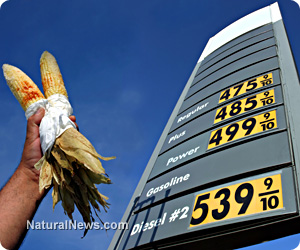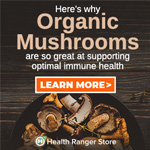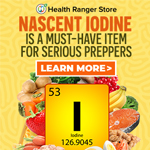
U.S. food prices up 19 percent in 2014; increasing inflation feared
Monday, April 14, 2014 by: J. D. Heyes
Tags: increasing food prices, California drought, subsidized crops
- Dr. Mary Talley Bowden drops bombshells about children being permanently damaged by mRNA jabs during Tucker Carlson interview
- Aerosolized bioweapons? Strange “diploid biomasses” falling out of the sky in Florida captured under the microscope
- COVID mRNA injections linked to genetic changes that increase brain tumor and leukemia risk
- After Jenny McCarthy's son got AUTISM FROM MMR VACCINE, a PR Firm was hired by U.S. government agency to label her an "ANTI-VACCINE KOOK"
- The smallpox vaccine was not a medical miracle – its history was marred by scandals
- Hawthorn: A timeless medicinal marvel
- YOU'RE FIRED! Trump begins mass layoffs at FDA, CDC, other corrupt, inefficient, money-wasting U.S. health agencies
- Tesla unveils enhanced Optimus robot, now walks better than Joe Biden!
- Faraday bags: The ultimate defense against digital theft and EMP attacks
- Douglas Mulhall’s “Our Molecular Future” explains how emerging technologies will redefine humanity
- Small-town patriots defeat CCP-linked battery giant: How Michigan stopped a communist incursion
- Greenland's strategic riches: The new Cold War frontier as U.S. and China vie for Arctic dominance
- Tofu: Health benefits, nutrients and how to eat this superfood
- The hidden power: Unveiling the national banking money monopoly in America
- Tornado outbreak and flash floods gripping the Midwest: Days of devastation await
- Trump’s shift in policy could save American farmers from climate regulations and bureaucratic red tape
- Trump's tough trade move: Short-term pain for consumers, long-term victory for U.S. workers!
- Alaska Natives cheer Trump's energy revival: “Our voices are finally being heard”
- Newly released JFK files reveal Pentagon's role in creating Lyme disease and covid in the same lab
- European Court of Justice: Healthcare professionals who promoted or administered COVID-19 vaccines are CRIMINALLY LIABLE for any harm caused
- Oncologist warns of ‘terrifyingly aggressive’ cancers in children, linked to immune suppression from COVID vaccines
- Kiss Your Genetic Privacy Good-Bye! 23andMe Gets Green Light to Sell Your Intimate Genetic Details to Anyone They Want
- Aerosolized bioweapons? Strange “diploid biomasses” falling out of the sky in Florida captured under the microscope
- Analysis: The coming economic collapse, a mass uprising and Trump's three secret weapons to halt the growing revolt
- Britain’s descent into police state censorship: Parents raided for questioning their daughter’s school system online
- AI weather model outperforms traditional forecasts, boosts accuracy by 20%
- Woman contracts WORLD'S DEADLIEST VIRUS after unknowingly being given the WRONG VACCINE
- NIH study, buried for decades, reveals that Flu Shots INCREASE elderly deaths, not prevent them
- Utah governor allows ban on LGBT pride flags in public buildings and schools, will take effect without his signature
- DARPA: The shadowy innovator behind the world’s most advanced military technologies
- The Health Ranger releases “Vaccine Zombie” song and music video, using AI-animated zombies for the music video
- COVID-19 scandal linked to CANCER SURGE: Billionaire researcher sounds alarm
- Musk targets “strangely wealthy” lawmakers in DOGE probe, names Pelosi, McConnell, Schumer
- Mike Adams releases country western hit single: Goin’ Back in Time is Comin’ Home
- When antibiotics are unavailable, natural ANTIMICROBIAL compounds become essential first line defenses against infection
- Ancient kitchen secrets REVEALED: How garlic, ginger and green onions fight cancer and heart disease
- Newly released JFK files reveal Pentagon's role in creating Lyme disease and covid in the same lab
- California's social media censorship law struck down: A victory for free speech or a threat to online safety?
- The Health Ranger releases “Vaccine Zombie” song and music video, using AI-animated zombies for the music video
- Dr. Mike Yeadon releases 15-minute testimony - WATCH - about genocidal intent of COVID “vaccines”
- EPA advisor admits the agency is funneling billions to climate groups ahead of Trump’s return to White House
- Florida takes a stand: DeSantis proposes permanent ban on mRNA vaccine mandates
- Rep. Nancy Mace introduces bill to ban biological males from female facilities on federal property
- Sugarcane extract superior to cholesterol-lowering drugs?
- Mike Adams releases country western hit single: Goin’ Back in Time is Comin’ Home
- Survival 101: Effective EMF blocking techniques
- “Why we influenced the 2020 elections”: Facebook files reveal the coordinated effort to bury the Hunter Biden laptop story
- Unpacking the Lies That We’ve Been Fed – new song and music video released by Mike Adams, the Health Ranger
- Attorney and TikTok influencer explains how he was offered hundreds of dollars to make false claims about Trump, Republicans
- OpenAI whistleblower who dissented against how the company trained ChatGPT found dead
- House Intelligence Committee calls for the ARREST and PROSECUTION of Dr. Anthony Fauci
- CONSERVATIVES SOUND THE ALARM: Big Pharma and the Left trying to force $32 billion money grab from America’s seniors into year-end spending deal
- Pilots report mysterious lights 'moving at extreme speeds' across Oregon skies
- Midair collision near D.C. kills 67; Questions mount over preventable tragedy
- Red Cross issues warning to stop blood plasma donations from vaccinated people
- Scientists confirm: GENIUS brain function can be spontaneously unleashed in humans without any apparent cause
- EPA advisor admits the agency is funneling billions to climate groups ahead of Trump’s return to White House
- HYSSOP: What research reveals about the health benefits of this ancient holy herb
- Two containers with completed ballots fall out of truck in Florida
- Fully vaccinated about to see “tsunami” of illness and death, warns virologist
- Global leaders unite to clamp down on “misinformation” with UN-backed Cascais Declaration
- BREAKING: 2025 NDAA authorizes mandatory military draft of WOMEN across America… as Pentagon pursues global NUCLEAR war with both Russia and China at the same time
- Michael Yon warns of a ZIONIST TAKEOVER in Trump’s second administration
- Newly released JFK files reveal Pentagon's role in creating Lyme disease and covid in the same lab
- BOMBSHELL: DNA testing kits are a SCAM to develop ethnic-specific bioweapons
- Ozempic and Wegovy weight loss drugs are injectable LIZARD VENOM PEPTIDES that may unleash a devastating wave of organ failure… side effects align with symptoms of SNAKE BITES
- Israeli soldiers accused of even more torture and abuse in the West Bank
- These 13 countries just signed an agreement to engineer a global FAMINE by destroying food supply
- The Health Ranger releases “Vaccine Zombie” song and music video, using AI-animated zombies for the music video
- NASA admits that climate change occurs because of changes in Earth’s solar orbit, and NOT because of SUVs and fossil fuels
- RFK Jr. clears key hurdle: Sen. Susan Collins backs controversial HHS nominee, signaling a new era for health policy
- Sermon 30: How Jesus reveals Caesar’s FAKE CURRENCY and FALSE AUTHORITY
"We are sure the weather is to blame but what happens when pent-up demand (from a frosty east coast emerging from its hibernation) bumps up against a drought-stricken west coast unable to plant to meet that demand? The spot price (not futures speculation-driven) of US Foodstuffs is the best performing asset in 2014 - up a staggering 19 percent," notes Tyler Durden over at Zero Hedge.
In February, the site gave voice to a sort of prelude to the aforementioned scenario, in publishing a post by Michael Snyder of The Economic Collapse blog:
Did you know that the U.S. state that produces the most vegetables is going through the worst drought it has ever experienced and that the size of the total U.S. cattle herd is now the smallest that it has been since 1951? Just the other day, a CBS News article boldly declared that "food prices soar as incomes stand still," but the truth is that this is only just the beginning. If the drought that has been devastating farmers and ranchers out west continues, we are going to see prices for meat, fruits and vegetables soar into the stratosphere.
A number of factors are leading to price increases
Sure, prices are up because California's drought is limiting supply. Some have even said that commodities prices are being pushed upward by speculators on Wall Street; that may be happening to an extent.But there are a number of other factors that the government doesn't report as having much of an effect at all on food prices (and remember, the government doesn't include "volatile" food and energy prices in its monthly inflation reports).
Speaking of energy, the price of a gallon of fuel, especially diesel fuel, has a lot to do with the prices you pay at the grocery store. Historically, food supplies were more much more local; transportation costs, therefore, were much reduced (and that was during the era of much cheaper fuel). Not anymore; the impact on prices that California's drought is having demonstrates how vast the U.S. food supply chain has become. With it has come higher transport costs.
Kimberly Amadeo, a U.S. Economy Guide at About.com notes:
Food prices rise in response to high gas prices. That's because transportation is a large cost of food you buy at the store. When you notice prices at the pump rising, expect to see the same thing happen in about six weeks at the grocery store. High gas prices are, themselves, usually caused by high oil prices. Here again, it usually takes about six weeks for increases in oil futures to translate to the pump.
Government policies don't help keep prices down
Regulations and laws are also behind the increase. As NaturalNews has reported, with Americans hungry and hundreds of millions around the world starving, U.S. lawmakers have adopted an insane policy of burning up our food supply in the form of a corn-based ethanol fuel mandate (and by the way, ethanol-laced fuel gets much worse mileage, meaning you have to buy more of it to get where you're going).It's a policy that has never made much sense, but adopted more as a sop to Big Agriculture creating a market that otherwise would not have existed. Also, growing corn for ethanol reduces the available farm land to grow food crops.
What's more, a recent Congressional Budget Office report concluded that the increased use of ethanol accounts for 10-15 percent of the increase in food prices.
Speaking of inane government policy, ever-changing subsidies for certain crops (which creates shortages) and paying farmers in some regions not to grow crops are two more factors that enhance shortages.
Sources for this article include:
http://www.zerohedge.com
http://theeconomiccollapseblog.com
Increasing food prices at FETCH.news
Get independent news alerts on natural cures, food lab tests, cannabis medicine, science, robotics, drones, privacy and more.
Take Action: Support Natural News by linking to this article from your website
Permalink to this article:
Embed article link: (copy HTML code below):
Reprinting this article:
Non-commercial use OK, cite NaturalNews.com with clickable link.
Follow Natural News on Facebook, Twitter, Google Plus, and Pinterest
Science News & Studies
Medicine News and Information
Food News & Studies
Health News & Studies
Herbs News & Information
Pollution News & Studies
Cancer News & Studies
Climate News & Studies
Survival News & Information
Gear News & Information
News covering technology, stocks, hackers, and more



"Big Tech and mainstream media are constantly trying to silence the independent voices that dare to bring you the truth about toxic food ingredients, dangerous medications and the failed, fraudulent science of the profit-driven medical establishment.
Email is one of the best ways to make sure you stay informed, without the censorship of the tech giants (Google, Apple, Facebook, Twitter, YouTube, etc.). Stay informed and you'll even likely learn information that may help save your own life."
–The Health Ranger, Mike Adams













































